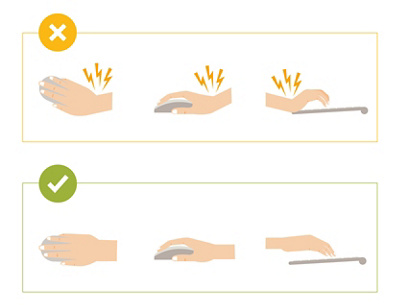Tenosynovitis causes the trochlear groove, i.e. the tendon sheath in which the muscle tendons slide, to become inflamed. Tenosynovitis can principally affect every tendon. Tendon sheath inflammation is observed most frequently on the wrist and foot.
Overview of tendon sheaths
Tendons are the connecting elements between muscles and bones and transmit muscle power and thus ensure mobility and stability in the body. At certain points, particularly where the tendons pass over bony prominences, they are surrounded by a fluid-filled connective sheath of tissue, known as a tendon sheath. The job of this tendon sheath is to protect the tendons from excessive friction and pressure, ensuring that the tendons glide smoothly.
Causes
Tendon inflammation often occurs in the thumbs (De Quervain’s tenosynovitis), wrists, arms and feet and is usually caused by chronic overloading of the tendons on a long-term basis. In rarer cases, however, it can also be triggered by a bacterial infection or rheumatic diseases:
Tendon overload
The most common cause of tenosynovitis is overuse due to repetitive movements, such as those involved in certain sports (e.g. tennis, cross-country skiing or running) or activities (e.g. working at a computer for long periods). Exertion resulting from workplace activities, such as that experienced by those working in craft industries or as musicians, can also lead to the development of the condition. However, tenosynovitis or tendonitis of the wrist should not be confused with carpal tunnel syndrome, which results from compression of the nerves.
Bacterial infection
In addition to chronic overloading, tendonitis can also be caused in rare cases by bacterial infections, for example after a puncture wound. A puncture wound can break through the skin’s natural barrier and introduce bacteria directly into the tendon sheath. In such cases, the introduced bacteria can cause an infection that develops into tendonitis.
Rheumatic diseases
Rheumatic diseases such as rheumatoid arthritis are autoimmune diseases in which the immune system mistakenly attacks the body’s own tissue. The tendon sheaths can also be affected as part of this process. The chronic inflammation that is characteristic of rheumatic diseases causes the tissue in the tendon sheaths to swell and become inflamed. In addition to rheumatoid arthritis, diabetes and gout can also increase the risk of tendonitis.
Symptoms
The main symptom of tenosynovitis is a dull pain that runs along the tendon and the associated muscle. This pain typically intensifies when pressure is applied to the affected tendon and when the muscle is moved. In severe cases, the pain may even persist during periods of rest.
Other symptoms of tendonitis may include:
- Redness and warmth along the inflamed tendon
- Nodular thickening of the tendons
- Crunching or rubbing noises when moving the tendon
- Restriction of movement in the affected area
- ‘Trigger finger’ phenomenon: sudden forward movement of the finger when stretching the fingers (stenosing tenosynovitis).
Diagnosis
Tendonitis is usually diagnosed by taking a thorough medical history and performing a physical examination. During this process, a specialist in orthopaedics examines the affected area for pressure pain, swelling and restricted movement. If necessary, a blood test is carried out to detect a bacterial infection or to rule out a rheumatic disease.
Treatment
Conservative treatment
Tendonitis is usually treated conservatively with the primary aim of protecting and immobilising the affected area and relieving pain. In most cases, tendonitis heals within a few weeks, provided the affected area is sufficiently rested. The following aids can be used to support the healing process:
- Splints or bandages: stabilise and relieve the affected tendons and muscles.
- Ice treatment: relieves pain and reduces inflammation.
- Anti-inflammatory medications: used as an ointment or in tablet form to combat inflammation.
- Physiotherapy: supports healing through targeted exercises that improve mobility and relieve muscle tension.
- Electrical stimulation: promotes blood circulation and supports healing.
- Shockwave therapy: stimulates the healing process in deep tissue.
Surgical treatment
Surgical treatment, in which the tendon sheath is split surgically, is only considered for patients with chronic tendonitis. Splitting the tendon sheath is intended to relieve the tendon and allow it to glide smoothly again, which may be necessary particularly in the case of long-term inflammation that is resistant to treatment. This procedure is used when conservative treatments, such as immobilisation, physiotherapy or medication, do not bring about sufficient improvement.
Prevention
To prevent tendonitis, it is important to avoid movements that may lead to tendon overload, both at work and during sporting activities.
Prevention in the workplace
Preventing tendonitis in the workplace begins with an ergonomic design of the working environment. Particularly in the case of activities that require repetitive movements, such as working at a computer, it is important to set up the workstation in a way that minimises strain on tendons and joints.
In addition, regular breaks should be taken to allow the tendons and joints to recover. These breaks can be supplemented with simple stretching and relaxation exercises.
Prevention during sport
To prevent inflammation of the tendon sheath, warm-up exercises should be performed before sporting activities to optimally prepare the muscles and tendons for the upcoming stresses. It is also important to listen to the body’s signals: if pain occurs during an activity, the load should be reduced immediately or the activity stopped.
Centres 4
-
Outpatient Clinic Permanence
Bümplizstrasse 83
3018 Bern




